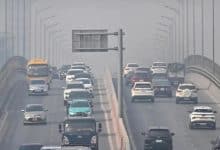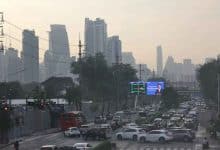Hazardous haze engulfs Thailand provinces with dangerous PM2.5 levels

A hazardous haze of ultra-fine dust engulfed 35 out of Thailand’s 77 provinces this morning, January 28, predominantly affecting the central plains. This information was revealed in a recent report by the Geo-Informatics and Space Technology Development Agency, which was released at 8am.
The report classified nine provinces as suffering from red-level air pollution, indicating serious harm due to the presence of particulate matter 2.5 micrometres or smaller in diameter (PM2.5). Topping the list was Samut Songkhram province, recording a whopping 108.6 microgrammes of PM2.5 per cubic metre of air in the past 24 hours, nearly triple the safe threshold of 37.5µg/m³.
The eight other provinces facing severe PM2.5 levels were Samut Sakhon (104.4µg/m³), Ratchaburi (89.8), Petchaburi (87.9), Samut Prakan (85.3), Rayong (82.3), Chai Nat (79.0), Chon Buri (78.4), and Nakhon Pathom (75.5), reported Bangkok Post.
The situation was not much better in 26 other provinces, with each one experiencing orange-level PM2.5 readings, indicating initial harm. These readings ranged from 39.7 to 73.9µg/m³. The provinces in descending order of PM2.5 levels were Kanchanaburi, Bangkok, Chachoengsao, Nonthaburi, Prachuap Khiri Khan, Suphan Buri, Pathum Thani, Uthai Thani, Ayutthaya, Ang Thong, Nakhon Sawan, Trat, Prachin Buri, Sing Buri, Chanthaburi, Lop Buri, Sa Kaeo, Nakhon Nayok, Tak, Kamphaeng Phet, Saraburi, Phetchabun, Phichit, Nakhon Ratchasima, Lamphun, and Sukhothai.
In related news, the Pollution Control Department (PCD) warned residents of Bangkok to prepare for an escalation in ultra-fine particle pollution in the air, which is anticipated to worsen by Wednesday. As a result of this alert, the PCD has implored individuals residing in the capital to opt for remote working until the situation improves.
The intensifying accumulation of PM2.5 pollutants, according to Preeyaporn Suwanakate, the PCD’s director-general, is a consequence of compromised air circulation in several areas across the city. This complication is largely attributed to the combination of low atmospheric pressure and fluctuating wind patterns in the region, leading to the buildup of pollutants.
Latest Thailand News
Follow The Thaiger on Google News:


























